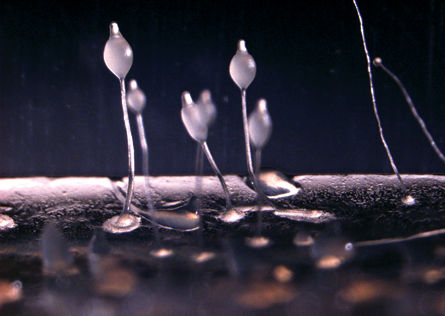Birds, bees and educated fleas actually don’t do it. But a social amoeba turns out to practice a simple form of agriculture in the form of bacterial husbandry.

Dictyostelium discoideum, aka the slime mold, is the latest member in a small club of species known to practice farming. It’s not fancy. But 13 out of 35 wild strains of the tiny soil-dwelling creature routinely stop grazing on their bacterial food while there’s still some left, reports Debra A. Brock of Rice University in Houston. The social amoebas then mix uneaten bacteria into reproductive structures that release spores complete with starter kits for planting a new food patch, Brock and her colleagues report in the Jan. 20 Nature.
There’s no evidence so far that the social amoebas tend a bacterial crop once it starts growing, notes evolutionary geneticist Duur Aanen of Wageningen University in the Netherlands, who wasn’t part of the research. Yet, he says, “the example described in this paper really fulfills the definition of farming: carrying, seeding and prudent harvesting of food.”
The short list of farmer species — including certain ants, termites, beetles as well a salt marsh snail and a damselfish — has intrigued scientists searching for shared features. “One such commonality is that farming occurs in societies,” Aanen says, a pattern reinforced by the social amoebas.
These aren’t the blobby one-celled protozoans that children draw when they first learn about microscopic life. Though Dictyostelium, or “Dicty,” social amoebas and their relatives do start life as individual blobs oozing around, when food runs low “they start talking to each other,” Brock says. Chemical signals bring individuals, typically genetically identical clones, into swirling streams that eventually mass together, and what had been a population of single cells turns into a single multicellular organism. It creeps along searching for food and eventually transforming into a spore-bearing sphere on a skinny stalk.
“It’s very entertaining to watch,” Brock says.
Dicty farming has gone undiscovered for decades, Brock says, because biologists studying the marvels of its lifestyle focused on a particular strain that’s easy to grow in the lab. It happened, Brock now knows, to be one of the nonfarmer strains. Only when Rice biologists David Queller and Joan Strassmann, coauthors of the new paper, started collecting the species in the wild did they notice something extra — bits of several edible kinds of bacteria — in some of the spore-bearing bodies.
To see whether the bacterial “contaminants” were affecting the social amoebas, Brock and her colleagues put spores of various strains on lab dishes loaded with nutrients that could support bacteria. The farmer strains, which came with their own bacteria, flourished, but the nonfarmer strains faltered without a food supply and barely managed to make any spores.
Farming comes with a cost, though. When the researchers provided edible bacteria for all strains, the nonfarmers had the advantage. Farmers stopped feeding early and formed spores before exhausting the food supply, while nonfarmers continued to feed and grow until virtually all the bacteria were gone.
In a test with real-world soil, samples didn’t include bacteria that the social amoebas liked, and the farmers outperformed the nonfarmers. As conditions vary, the advantage could shift, allowing both farmers and nonfarmers to persist in a wild population.






